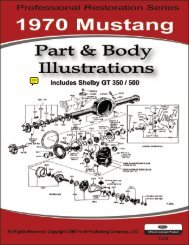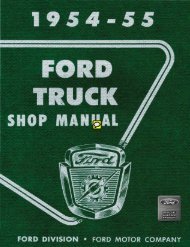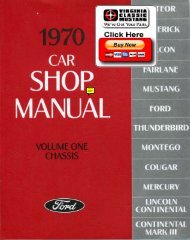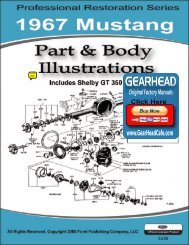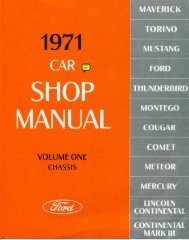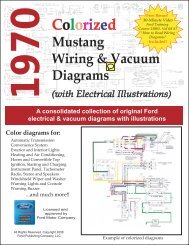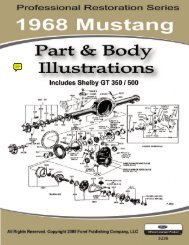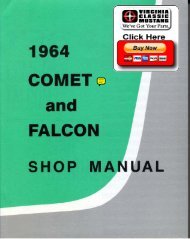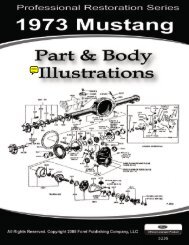DEMO - 1959 Ford Thunderbird Shop Manual - ForelPublishing.com
DEMO - 1959 Ford Thunderbird Shop Manual - ForelPublishing.com
DEMO - 1959 Ford Thunderbird Shop Manual - ForelPublishing.com
You also want an ePaper? Increase the reach of your titles
YUMPU automatically turns print PDFs into web optimized ePapers that Google loves.
PART 1-1- GENERAL ENGINE SERVICE 1-17<br />
Tool-RC-500<br />
FIG. 18 Cleaning Ring Grooves Typical<br />
The step will interfere with ring<br />
operation and cause excessive ring<br />
side clearance.<br />
Spongy, eroded areas near the<br />
edge of the top<br />
of the piston are<br />
usually caused by detonation, or<br />
pre-ignition. A shiny surface on the<br />
thrust surface of the piston, offset<br />
from the centerline between the pis<br />
ton pin holes, can be caused by a<br />
bent connecting rod.<br />
Replace pis<br />
tons that show signs of excessive<br />
wear, wavy ring lands, fractures,<br />
and/or damage from detonation or<br />
pre-ignition.<br />
Check the piston to cylinder bore<br />
clearance with a tension scale and<br />
ribbon and the ring side clearance<br />
following the re<strong>com</strong>mended pro<br />
cedures.<br />
Replace piston pins showing signs<br />
of fracture or etching and/or wear.<br />
On a 352 engine, check the piston<br />
pin fit in the piston and rod bushing.<br />
To check the pin fit in the con<br />
necting rod of a 430 engine, refer<br />
to Part 1-3.<br />
Replace all rings that are scored,<br />
chipped,<br />
gap<br />
or cracked. Check the end<br />
and side clearance. It is good<br />
practice to always install new rings<br />
when overhauling<br />
the engine. Rings<br />
should not be transferred from one<br />
piston to another regardless of<br />
mileage.<br />
FITTING PISTONS<br />
Pistons are available for service<br />
in standard sizes and 0.003, 0.020,<br />
0.030, 0.040, and 0.060-inch over<br />
size. Standard size pistons are divided<br />
into two sizes and are identified by<br />
a daub of red or blue paint. Refer to<br />
the specification section for the avail<br />
able sizes.<br />
The piston and cylinder block<br />
should be at room temperature<br />
(70F) when the piston fit is<br />
checked. After any refinishing<br />
op-<br />
FIG. 19-Checking<br />
eration, allow the cylinder bore to<br />
cool before the piston fit is checked.<br />
Calculate the size<br />
piston to be<br />
used by taking a cylinder bore check<br />
(Fig. 25), then select the proper size<br />
piston to provide the desired clear<br />
ance.<br />
Make sure the piston and cylinder<br />
bore are clean and dry. Attach a<br />
tension scale to the end of a feeler<br />
gauge ribbon that is free of dents<br />
or burrs. The feeler ribbon should be<br />
Vi inch wide and of one of the thick<br />
nesses listed in Table 4.<br />
Position the ribbon in the cyl<br />
inder bore so that it extends the<br />
entire length of the piston at<br />
90<br />
from the piston pin location. Invert<br />
the piston and install it in the bore<br />
so that the end of the piston is about<br />
1 % inches below the top<br />
of the<br />
cylinder block and the piston pin<br />
is parallel to the crankshaft axis.<br />
Hold the piston and slowly pull<br />
the scale in a straight line with the<br />
ribbon, noting the pull required to<br />
remove the feeler ribbon (Fig. 19).<br />
The piston to cylinder bore clearance<br />
should be from 0.0011-0.0029 inch.<br />
The wear limit is 0.005 inch.<br />
In Table 4, the diagonal lines rep<br />
resent feeler ribbons of various thick<br />
nesses, the horizontal lines represent<br />
the pounds pull, and the vertical lines<br />
represent the clearances. To deter<br />
mine the clearance, locate the line<br />
representing the pounds pull required<br />
to remove the feeler ribbon from the<br />
cylinder bore. Follow the horizontal<br />
Piston Fit Typical<br />
1741-A<br />
line to the right until it intersects the<br />
diagonal line representing the feeler<br />
ribbon. Read down the vertical line<br />
for the clearance.<br />
Example 1. If a 0.0015-inch feeler<br />
ribbon is used and it takes approxi<br />
mately AVa pounds pull to remove<br />
the feeler ribbon, the clearance is ap<br />
proximately 0.0008 inch. This is de<br />
termined by locating the pounds pull<br />
{AVa) in Table 4 and<br />
following the<br />
line to the right until it intersects<br />
with the diagonal line representing<br />
the 0.0015-inch feeler ribbon. Read<br />
down the vertical line for the clear<br />
ance<br />
(approximately 0.0008 inch).<br />
Example 2. If a 0.003-inch feeler<br />
ribbon is used and it takes approxi<br />
mately 9 pounds pull to remove the<br />
ribbon, the resultant clearance is ap<br />
proximately 0.0015 inch.<br />
Example 3. If a 0.003-inch feeler<br />
ribbon is used and it takes approxi<br />
mately 4 pounds pull to remove the<br />
feeler ribbon, the resultant clearance<br />
is approximately 0.0026 inch.<br />
If the clearance is greater than the<br />
maximum limit, recheck calculations<br />
to be sure that the proper size piston<br />
has been selected, check for a dam<br />
aged piston, then try a new piston.<br />
If the clearance is less than the<br />
minimum limit, recheck calculations<br />
before trying another piston. If none<br />
can be fitted, refinish the cylinder for<br />
the next size piston.<br />
When a<br />
piston has been fitted,<br />
mark it for assembly in the cylinder<br />
to which it was fitted.




